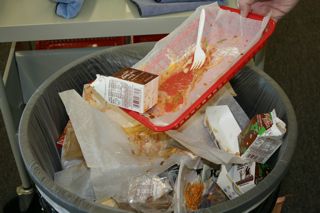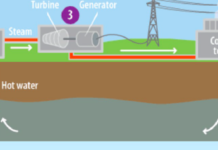Ever wondered how much trash comes out of a school? Has your school ever gotten a waste audit a method of estimating the total amount of waste discarded, the cost, and the amounts of waste that can be recycled or reused?
Schools are a huge producer of waste. Can schools be more ecofriendly?
 According to the website, Earth Share, an environmental group dedicated to promoting environmental education, on average, one student will produce 67 pounds of waste in a school year from bringing lunch to school. This adds up to 18,000 pounds a year for an average elementary school. The majority of the wastes are paper materials and food waste, according to Recycle Now, a website that tells you what can be recycled and how to go about doing it.
According to the website, Earth Share, an environmental group dedicated to promoting environmental education, on average, one student will produce 67 pounds of waste in a school year from bringing lunch to school. This adds up to 18,000 pounds a year for an average elementary school. The majority of the wastes are paper materials and food waste, according to Recycle Now, a website that tells you what can be recycled and how to go about doing it.
If schools operate in a more environmentally conscious way, not only does it create a much cleaner environment and reduce pollution, but lowers the school’s cost of operating. For example, research conducted by the U.S Department of Energy (DOE) shows that one of the highest expenditures for a school is their energy cost. Public schools spend over 8 billion dollars a year in energy costs! School districts can lower their energy cost by up to 20–30% by implementing energy efficient operations and maintenance, such as switching from T12 to T8 fluorescent light tubes; T8 use less energy but give the same amount of lighting, according to DOE.
Another great way to save energy is simply turning off unused computers, which cost $0.01 to $0.03 per hour to leave on, according to DOE. The best way would be to educate the school staff and students on energy consumption and ways to save energy so staff can implement this energy plans adds DOE.
The staff of Francis Howell High School in St. Charles, MO, has taken the initiative to decrease the school’s effect on the environment. “Our school is working with a new waste and recycling company that recycles everything but food. The year before the school used to throw everything in the trash with the old company,” says Ann Clynes, a lunchroom employee. “This new company gives the school a 100% increase in waste being recycled along with eco friendly detergents,” adds Bill Clynes.
The Clynes also mentioned that the school had employed reusable plastic red trays to substitute the paper trays to reduce cost. Unfortunately, students wouldn’t return the trays and threw them away and we had to switch back to the paper trays.
Most of the student body believes the school could be doing a much better job.
“The school is extremely inefficient in energy consumption such as lights and computers,” says Brendan Gowen, a senior at Francis Howell High. “The school leaves most of the lights on at night when they really don’t have any reason to do so.”
Zach Shultz, a senior at Francis Howell High explains, “The school is not doing enough to create a more eco friendly facility and the last thing on the school board’s mind is the efficiency rating of the school, the school can do much more.” Other schools are becoming more eco-friendly.
“I agree that the school is currently inefficient and not very eco friendly,” says School Principal Dr. Chris Greiner. “But the new building that is currently being built [scheduled to be completed 2011] is much more efficient as far as lighting, and HVAC [heating, ventilation and air conditioning] with innovative features. The classrooms will have motion detection lighting which will sense if anyone is in the room and turn off the lights when the room is not in use. The school district is doing a great job on making the protection of the environment and the efficiency of their facilities a priority; like how the school will be expanding its cell membrane water treatment plant,” says Greiner. A cell membrane water treatment plant is an environmentally-friendly procedure to treat water before it flows into creeks.
Colleges are also coming under scrutiny. The Sierra Club’s October 2010 100 Coolest School Survey, which compares conservation and energy efficiencies of universities and colleges nationwide, lists Washington University in St.Louis at 43rd and University of Missouri-Kansas City came in 95th.
A similar challenge implemented on K-12 schools, called the Green Cup Challenge, was established by the Green Schools Alliance. They challenged schools to lower their carbon footprint by making simple changes like dimming the lights and adjusting the thermostats. With 161 schools participating, they say that they were able to achieve the equivalent of taking 162 cars off the road or planting 764 trees!

This work is licensed under a Creative Commons Attribution-NonCommercial-NoDerivs 3.0 Unported License














GREAT ARTICLEE! NICELY DONE!
good paper son!
I appreciated the thoughtfulness of your article, and the multiple sources you attributed, but I would have gotten to the local news story about Francis Howell’s decision to go green much sooner, and moved the (very good) contextual information closer to the end.
I really like the local angle you’ve included – and isn’t it interesting how it all comes back to costs and money? Nice reporting!
Nicely done Mobeen. This report is very well done!
I knew our school was not very eco-friendly, but I didn’t know how they were going to try to improve with the new school. That motion lighting thing is pretty cool.
Great article Mobeen!, I enjoyed reading it very much and it supplied me with a lot of information I had not known before. Keep up the good work!
This article makes me realize the significance of saving the environment in any way possible.
This article was well written. It is also super informative!
Great paper i like how you talk about what the school did and now what they are doing to make the environment better. Great Article!
I liked the topic and find that this is probably an issue that most schools face. I find it very interesting that each student on average has 67 pounds of waste just from bringing their lunch. I also liked how you got quoted people from our school including the principal.
I liked this article, I enjoyed reading how the new school would be more eco friendly. I was wondering though, other than just lights turning off at night what other ways is the new school going to be more eco friendly?
i really like the experts you used they add alot to your artical.
I found this article very interesting! I never thought schools could damage our environment. Great Topic!
I had no clue that our new school was going to be so eco friendly. I am glad that our school district is putting the effort into becoming more green because right now Francis Howell isnt doing much except recycle. Great article!
this is a very well written article, you used great sources
This is a very interesting article. I am happy to know that my school is becoming all it can to become eco friendly.
great article, i like all the quotes because it makes your article more enjoyable to read. its really eye opening to see how much waste schools produce. im excited about the new school being more green.
i didnt know that each student has that much trash a year.
It’s amazing to realize that one student could build up that much trash in a school year! Also, I was surprised that 161 schools could make such a difference–saving over 750 trees! Great article!